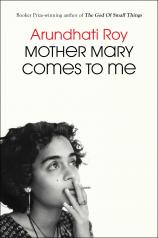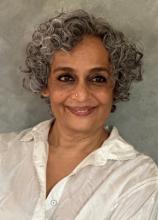Reading Group Guide
Discussion Questions
Mother Mary Comes to Me

1. In the opening pages, Arundhati Roy writes: “I have thought of my own life as a footnote to the things that really matter.... Maybe I pitched my tent where the wind blows strongest hoping it would blow my heart clean out of my body. Perhaps what I am about to write is a betrayal of my younger self by the person I have become” (3). In these lines, Roy names some of the ways she’s tried to understand herself: as a footnote; as the unwitting owner of a heart; as a betrayer of a younger version of herself that she was forced to leave behind in order to live. What is the tone of these descriptions of herself? What effect did they have on you?
2. THE GOD OF SMALL THINGS, Roy’s debut novel and a critical and bestselling phenomenon, is referenced often in the first few chapters, as the novel hews closely to Roy’s own life. She notes that the dedication page she wrote for the novel contains “a lie. A good one. I crafted it --- ‘she loved me enough to let me go’... [Mrs. Roy] quoted it often, as though it were God’s truth” (4). But, Roy admits, the actual truth is that “I left my mother...to be able to continue to love her. Staying would have made that impossible.” Consider these two statements. What is the difference between them?
3. At the end of the first chapter, Roy credits her lifelong pursuit of understanding her mother as the thing that made her a writer --- and notes that “perhaps even more than a daughter mourning the passing of her mother, I mourn her as a writer who has lost her most enthralling subject” (7). What is the difference between mourning someone as a daughter and as a writer? What is the difference between mourning a mother and a subject?
4. The symbol of “a cold, furry moth on a frightened heart...my constant companion” (22) recurs throughout the book. What does this moth symbolize? What effect does it have on Roy throughout her life? Can you point to some examples in the text?
5. Discuss how the dynamics of the family shifted after Mary founded her school. What existing dynamics did the school exacerbate, and to what extent did it usher in new ones?
6. As much as this memoir is about how Arundhati Roy became who she is today, it’s also about how Mary Roy became a legendary figure in her own right --- from a struggling single mother to a trailblazing figure known throughout the country. What was her impact? Why does Roy describe it as “revolutionary” (34)? And at what cost did all these achievements come?
7. Revisit pages 38–39. Discuss Mrs. Roy’s treatment of LKC and how it impacted Arundhati’s ideas of feminism from an early age, “fill[ing] it with caveats” (38). Roy writes, “My brother and I grew up in the cleft between that syrupy dream and our capricious nightmare, not always knowing which was worse. On balance, if we had to choose between the two, I think I’d choose our nightmare, and he, the dream” (39). What is the dream here, and what is the nightmare?
8. Choose a few moments from the text in which you can see Roy’s political consciousness and identity forming. What was she exposed to, or not exposed to, in her youth? How did this change through all her phases of adulthood, and what brought about these changes? How do you see this all bearing out in her later work?
9. Once in Goa, Roy arrives at yet another turning point in her life, and she describes her behavior as “inexplicable” (98). What is she running away from and why? What does she mean when she reflects on the fact that, throughout her life, “the safest place would become the most dangerous” (109)? When else does this happen in the memoir?
10. Periodically, Roy interrupts the flow of a paragraph with one interjection: Lucky. What does this repetition mean to you, and what larger themes does it resonate with? Were there times when you were surprised to find that she considered herself lucky? Do you agree that she has been lucky in her life?
11. Regarding her aspirations of being a writer, Roy remarks, “As a child, it’s all I ever thought I’d be...[but] even then I knew that the language I wrote in was not mine.... I don’t mean English, Hindi or Malayalam, I mean a writer’s language. Language that I used, not language that used me.... I knew even then that that language was outside me, not inside me. I knew it would not come to me on its own. I needed to hunt it down like prey.” (125–27). Discuss this passage with the group. What difficulties of language is Roy expressing here? Why did writing fall by the wayside for her --- and what conditions allowed her to resume writing?
12. Before she introduces the reader to her father, Roy notes, “It’s easier for me to write about politics, or to write fiction, than to write what I am about to write. There’s no glory in this. Nor --- relatively speaking --- any great tragedy. I wonder why I need to make this very private moment public” (142). What does this mean in the context of this scene in particular? How does this notion, the idea of making difficult private moments public, speak to the rest of the memoir?
13. What led Roy to feel “principled and hypocritical all at once” (220) in the years after she and Pradip inherited the property? She describes two “traps” in the chapter “Things Fall Apart.” What are they, and why do they feel like traps to her?
14. What distinction does Roy make between writers and activists, and why does she find the term “writer-activist” absurd? How does she define what a writer’s role is in society?
15. Roy describes the rise of Hindu nationalism and the BJP in India in tandem with the events of her own life. What effect did this have on you as a reader? Why was it important to Roy to give a strong sense of her political-social environment in the memoir?
16. Roy worked on THE MINISTRY OF UTMOST HAPPINESS for a decade, and in that time she also wrote some of her most potent and contentious nonfiction. As a result, she was hounded by threats of imprisonment, which have followed her throughout her life. At what points did her fiction writing and her nonfiction writing interrupt each other, and why?
17. Reflect on the final chapter of the book. How has Roy’s relationship with her mother changed? How has it stayed the same? What is Mary Roy’s legacy?
Mother Mary Comes to Me
- Publication Date: September 2, 2025
- Genres: Memoir, Nonfiction
- Hardcover: 352 pages
- Publisher: Scribner
- ISBN-10: 1668094711
- ISBN-13: 9781668094716







